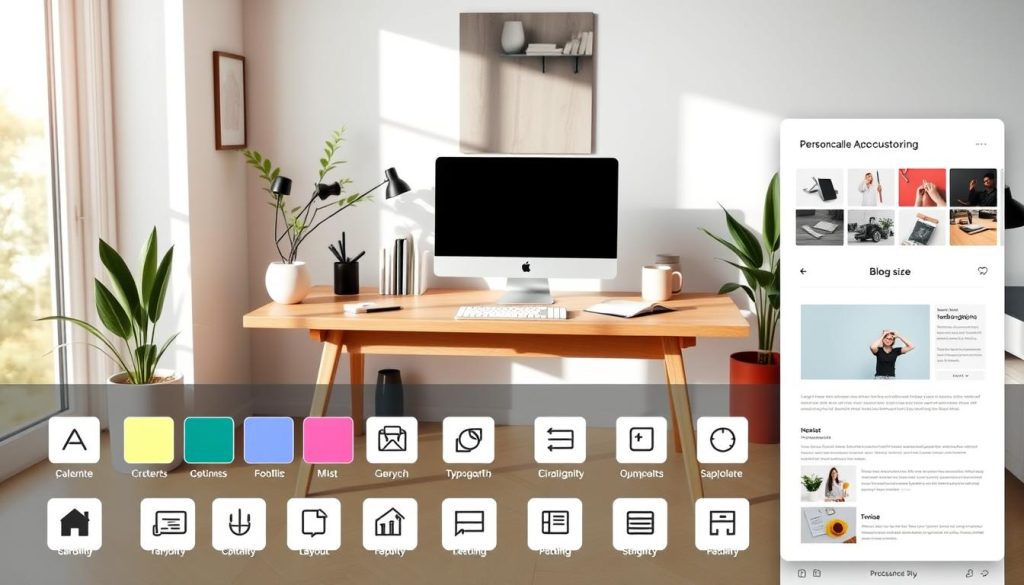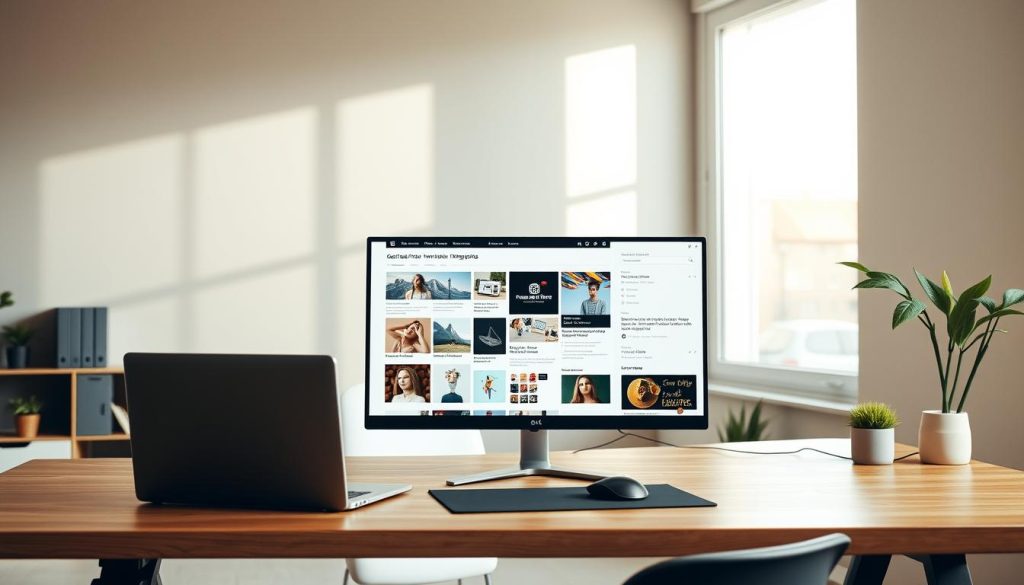Starting a blog is exciting, and you can do it in 20 minutes with basic computer skills, says Scott Chow. This guide is for beginners. It will take you through each step.
Blogging is very important. It lets you share ideas, show your expertise, and reach more people. This guide will cover the basics of setting up a blog and the best practices.
Key Takeaways
- Understand the basics of blogging and its importance.
- Learn the essential steps to set up a blog.
- Discover best practices for beginner bloggers.
- Get an overview of what to expect from the guide.
- Start blogging with confidence.
Understanding Blogs: What They Are and Why You Should Start One
Blogs are a big deal in the digital world. They let people share their thoughts and info. Blogs are websites with written content, called blog posts, shown in reverse order.
What Defines a Blog in Today’s Digital Landscape
Blogs are all about being personal and informal. They share articles, stories, or updates on certain topics. The writing is friendly and easy to connect with.
The Benefits of Blogging for Personal and Professional Growth
Blogging is great for many reasons. It lets you share what you know, meet others who think alike, and show you’re an expert. It also makes you a better writer, boosts creativity, and can open up new job doors.
| Benefits | Description |
|---|---|
| Personal Growth | Improves writing skills, fosters creativity, and enhances self-expression. |
| Professional Growth | Establishes expertise, opens up new career opportunities, and enhances online presence. |
Setting Realistic Expectations for New Bloggers
Starting a blog is a big job. It takes time, hard work, and sticking with it. It’s key to have realistic goals, be patient, and keep up with the digital world.
Knowing what blogs are and their benefits helps you decide to start your own blog.
Planning Your Blog: Essential Pre-Launch Decisions
Before you launch your blog, you need to make some key decisions. These decisions will shape your blog’s identity and direction. A well-planned blog is more likely to attract and keep a loyal audience. Let’s look at the essential pre-launch decisions you must make.
Defining Your Blog’s Purpose and Niche
Defining your blog’s purpose and niche is a foundational step. Your niche determines the topics you’ll cover, while your purpose outlines why you’re blogging. Paige Brunton says choosing a niche and defining your blog’s purpose are crucial initial steps.
To define your niche, think about your passions, expertise, and what topics you’re enthusiastic about. A clear purpose could be to educate, entertain, or inspire your readers.
Key considerations when defining your niche:
- Identify your areas of expertise
- Research popular and trending topics
- Consider your target audience’s interests
Identifying Your Target Audience
Understanding your target audience is vital for creating content that resonates with them. Your target audience is the group of people you’re trying to reach with your blog. To identify them, consider demographics, interests, and pain points.
Knowing your audience helps tailor your content, making it more engaging and relevant.
Steps to identify your target audience:
- Conduct market research to understand demographics and interests
- Analyze your competitors’ audiences
- Create buyer personas to guide your content creation
Creating a Content Strategy Calendar
A content strategy calendar is a plan for the content you’ll publish on your blog. It helps you stay organized and ensures consistency, which is key to keeping your audience engaged. When creating your calendar, consider the types of content you’ll produce, such as tutorials, reviews, or personal stories.
Benefits of a content strategy calendar:
- Helps maintain consistency in posting
- Ensures a balanced content mix
- Reduces last-minute content creation stress
By planning your blog carefully, you set yourself up for success in the blogging world. Effective planning involves defining your niche, understanding your audience, and organizing your content.
Choosing the Right Blogging Platform for Your Needs
There are many blogging platforms out there. Choosing the right one is key. Your platform is the base of your blog, shaping its look and how it works.

Self-Hosted vs. Free Blogging Platforms: Pros and Cons
First, you must decide between self-hosted or free platforms. Self-hosted platforms give you more control but need tech skills.
Free platforms are easy to start but limit design and money-making options. Knowing these differences helps you choose wisely for your blog.
| Features | Self-Hosted | Free Platforms |
|---|---|---|
| Customization | High | Limited |
| Monetization | Full Control | Limited |
| Technical Knowledge | Required | Minimal |
WordPress.org vs. WordPress.com, Blogger, and Other Options
Popular choices include WordPress.org, WordPress.com, Blogger, and Squarespace. WordPress.org is self-hosted, offering lots of customization and a big community. WordPress.com is easier but has fewer options than WordPress.org.
Blogger is free and works well with Google services. Scott Chow says using a hosting service like BlueHost makes setting up WordPress easier.
Making the Final Platform Decision Based on Your Goals
Your platform choice depends on your goals. For a professional blog setup, WordPress.org might be best. Beginners might prefer a free platform or WordPress.com.
Think about what you need: customization, making money, and ease of use. This helps you pick the right platform for your blogging journey, whether you’re a beginner or more experienced.
How to Set Up a Blog: The Step-by-Step Process
To start blogging, you need to follow a few key steps. These steps help build your online presence. They are crucial for your blog’s success.
Selecting and Registering Your Domain Name
The first step is to select and register a domain name that shows what your blog is about. It should be easy to remember and spell. Use sites like GoDaddy or Namecheap to see if your name is available and to register it.
Choosing a Reliable Web Hosting Provider
After getting your domain, pick a reliable web hosting provider. Your host will keep your blog’s files safe for visitors. Look at storage, bandwidth, support, and how it grows when choosing a host. Bluehost, SiteGround, and HostGator are good options.
Connecting Your Domain to Your Hosting
Next, connect your domain to your hosting. This means changing your domain’s DNS settings to point to your host. Your host will give you the DNS info and how to do it.
Installing Your Blogging Platform
The last step is to install your blogging platform. Most hosts make it easy with 1-click installs for platforms like WordPress. Or, you can download and install it yourself by following the instructions.
| Step | Description | Key Considerations |
|---|---|---|
| 1. Domain Registration | Register a domain name that reflects your brand or niche. | Memorability, relevance, availability |
| 2. Web Hosting Selection | Choose a web hosting provider that meets your needs. | Storage space, bandwidth, customer support, scalability |
| 3. Domain-Hosting Connection | Update your domain’s DNS settings to point to your web host. | DNS information, web host instructions |
| 4. Blogging Platform Installation | Install your chosen blogging platform. | 1-click installation, manual installation, platform compatibility |
Designing Your Blog for Maximum Impact
A well-designed blog makes your site more enjoyable and successful. The design is what visitors first see. It decides if they stay or leave.
Selecting the Perfect Theme for Your Blog
Choosing the right theme is key. It should be clean, responsive, and match your brand. Look for a theme that lets you customize easily.
Find a theme that’s SEO-friendly and well-liked by bloggers. A good theme speeds up your blog and improves its performance.

Customizing Your Blog’s Appearance
Customizing your blog is more than just changing colors and fonts. It’s about creating a brand image that connects with your audience. Paige Brunton says to make your blog more engaging by customizing it.
To customize well, focus on these areas:
- Logo and branding
- Color scheme and typography
- Layout and widget customization
By adjusting these, you can give your blog a unique and professional look.
| Customization Element | Description | Impact on Blog |
|---|---|---|
| Logo and Branding | Visual identity of your blog | Establishes recognition and trust |
| Color Scheme and Typography | Visual aesthetics and readability | Enhances user experience and engagement |
| Layout and Widget Customization | Organization and functionality | Improves navigation and accessibility |
Mobile Optimization Essentials
Most people use mobile devices to access the internet. So, making your blog mobile-friendly is essential. Make sure your theme is responsive and test it on different devices for a smooth experience.
Mobile optimization is key to keeping visitors and boosting your blog’s ranking. A mobile-friendly blog works well on all screen sizes, making your content easy to access for everyone.
Essential Pages and Settings for a Professional Blog
Starting a professional blog is more than just posting content. You need to set up key pages and adjust important settings. A well-organized blog makes it easier for users to find and explore your site. It also helps with search engine optimization (SEO).
Creating Your About, Contact, and Privacy Policy Pages
Every professional blog needs About, Contact, and Privacy Policy pages. The About page shares your background, expertise, and blog’s purpose. It helps you connect with readers and show your authority.
The Contact page lets readers reach out to you. It should have a contact form and your email or other contact info. This page is key for communication and potential collaborations.
A Privacy Policy page is both legal and builds trust. It explains how you handle data, including cookies and comments. It’s important for bloggers to detail their data protection practices.

Setting Up Categories and Navigation
Organizing your content with categories and clear navigation is vital. Categories help readers find similar content. A well-organized menu makes it easy for visitors to explore your blog.
Configuring Critical Blog Settings
Setting up your blog’s settings is a key step. This includes setting your blog’s title and tagline, configuring permalinks, and enabling comments. Permalinks should include the post title for better SEO. Also, enabling comments encourages reader engagement, but moderation is needed to keep it positive and spam-free.
By focusing on these essential pages and settings, you lay a strong foundation for your blog. This improves both user experience and your blog’s online visibility.
Creating and Publishing Your First Blog Posts
Your blog is ready for its first posts. This is a key step in setting your blog’s tone and attracting readers. Remember, the quality of your content is very important.
Crafting Engaging Headlines and Content
Start by making engaging headlines that grab attention. Your headline should be interesting and make readers want to click. When writing, focus on giving value to your readers.
Use a friendly tone and make your posts easy to read. Break up your content into smaller paragraphs and use subheadings. Add relevant keywords to help your blog show up in search results.
For beginners, blog building is more than just writing. It’s also about making your blog easy to use.
Adding Images and Media to Your Posts
Adding images and media makes your posts more engaging. Visuals help break up text and make your blog more appealing. Choose images that match your content and are high quality.

Publishing and Scheduling Content
After you’ve written your post, it’s time to publish it. Most platforms let you schedule your posts ahead of time. This helps keep your blog consistent.
Before publishing, check for any mistakes in grammar, spelling, or formatting. Also, optimize your post with meta descriptions and tags for better SEO. By doing these steps, you’ll be on your way to creating a successful blog that keeps readers coming back.
Promoting Your New Blog and Building an Audience
Promoting your blog is key to your blogging journey. It needs a mix of strategies to reach readers. Using different channels helps increase your blog’s visibility and build a loyal audience.
Social Media Strategies for New Bloggers
Social media is essential for promoting your blog. Creating engaging content on Facebook, Twitter, and Instagram can boost your blog’s traffic. Paige Brunton says using social media is vital for blog promotion.
For example, make a Facebook page for your blog and post updates. Twitter is great for sharing your posts and talking with other bloggers. Instagram is perfect for sharing images related to your blog.
Email Marketing and Newsletter Setup
Email marketing is a powerful way to promote your blog and attract readers. Creating a newsletter keeps your audience updated on new posts and news. You’ll need an email service like Mailchimp or ConvertKit to start.
Make your newsletter look good and include a clear call-to-action. This encourages readers to visit your blog. Regular newsletters help build a loyal following and increase blog traffic.
Networking with Other Bloggers in Your Niche
Networking with other bloggers is important for growing your audience. Collaborating with fellow bloggers opens up guest posting, joint social media promotions, and more. This can expand your reach.
Join blogging communities, attend events, and take part in online forums in your niche. Building a network of peers gives you insights and strategies to use for your blog.
Conclusion: Your Blog Launch Checklist
Now that you’ve set up your blog, it’s time to launch. A detailed checklist can help make your launch smooth and successful. Scott Chow suggests checking key elements to make sure your blog is ready for everyone.
To start a blog, confirm your domain, hosting, and platform. Make sure your blog looks good and works well on phones. Also, create important pages like About, Contact, and Privacy Policy.
Before you go live, test your blog’s features. Check how easy it is to navigate and publish content. Also, connect your social media and get ready to promote your blog. This will help you build a strong online presence.
Use this guide to check your work: confirm your domain and hosting, install your platform, design your blog, and create essential pages. After these steps, you’ll be ready to launch and share your content with your audience.
FAQ
What is the best blogging platform for beginners?
WordPress.org and WordPress.com are top picks for bloggers. They offer lots of customization options. But, the best platform for you depends on your needs and goals.
How do I choose a niche for my blog?
Pick a niche that you’re passionate about and good at. Think about who you want to reach. Look into popular topics and trends in your niche to find an audience.
What are the essential pages I need to create for my blog?
You need an About page, Contact page, and Privacy Policy page. They help you look professional and follow the law.
How do I optimize my blog for mobile devices?
Use a responsive theme and optimize your images. Test your blog on different devices for a great user experience.
What is the best way to promote my new blog?
Use social media, email marketing, and network with other bloggers. This helps you reach more people and build a loyal following.
How often should I post new content on my blog?
Post regularly, whether it’s weekly, biweekly, or monthly. This keeps your audience interested and coming back for more.
Can I make money from my blog?
Yes, you can earn money through ads, affiliate marketing, sponsored posts, and selling products. But, you need a big and engaged audience.
How do I register a domain name for my blog?
Register your domain name at GoDaddy or Namecheap. Then, connect it to your web hosting provider.
What is web hosting, and why do I need it?
Web hosting stores your blog’s files so people can see them. You need a reliable host to keep your blog up and running.
